#Chesapeake & Ohio Allegheny
Text
While traveling during my holiday vacation, I met someone special!

Say hello to 1601 of the late Chesapeake & Ohio Railway! She’s an Allegheny, one of an engine class bested in size only by the Big Boys.
#c&o 1601#chesapeake & ohio 1601#allegheny locomotive#class h-8#my photos#trains#real life railways#real railway stuff#2-6-6-6#steam engines#steam locomotive#i love her so much
78 notes
·
View notes
Text

PAT 6691 @ B&O Glenwood Shop (Ex-WAG 2300 Nee SP T&NO 365)
Pittsburgh, PA
May 3, 1981
#commuter train#patrain#port authority of allegheny county#c&o#chesapeake & ohio#1981#pittsburgh#trains#passenger train#freight train#history#pennsylvania
13 notes
·
View notes
Photo

Day 7: Chesapeake & Ohio Allegheny
Info from Wikipedia:
The Chesapeake and Ohio H-8 was a class of 60 2-6-6-6 steam locomotives built by the Lima Locomotive Works in Lima, Ohio between 1941 and 1948 and operated until the mid 1950s. The locomotives were among the most powerful steam locomotives ever built and hauled fast and heavy freight trains for the railroad and two have been preserved, Nos. 1601 and 1604.
Built for hauling freight through the Allegheny Mountains, the locomotives were given the nickname "Alleghenies". Each H-8 cost around $230,000. They could operate an 11,500-ton coal train at up to 45 mph and up to 60 mph pulling passenger trains. They also had the heaviest axle load of any steam locomotive, with a maximum axle load of 86,700 lbs. Gene Huddleston's book, "C&O Power", reports tests of the C&O with a dynamometer car indicating momentary readings of 7,498 hp (5.6 MW) with readings between 6,700 to 6,900 hp (5.0 to 5.1 MW) at about 45 mph (72 km/h). No one has published a higher dynamometer horsepower for any steam locomotive. The locomotive was built to power coal trains on the 0.57% eastward climb from White Sulphur Springs, West Virginia to Alleghany, Virginia. With one at the front and another at the back, 11,500-ton coal trains left Hinton, WV and were at full throttle from White Sulphur Springs to the top of the grade at Alleghany. C&O's 2-6-6-6s also handled coal trains from West Virginia to Columbus, Ohio. Huddleston says that 23 locomotives were equipped with steam piping for heating passenger trains. Upon dieselisation, retirement started in 1952 and by 1956, all of the Alleghenies have been retired.
No. 1642 suffered a crown sheet failure and subsequent boiler explosion at Hinton, WV in June, 1953. The crew did not survive the blast.
Two Alleghenies have been preserved:
No. 1601 was retired in 1956 and donated to the Henry Ford Museum in Dearborn, Michigan where it has been on display indoors since.
No. 1604 was initially sent to C&O's scrap lines behind their diesel shops at Russell, Kentucky upon retirement. It was then donated to the Virginia Museum of Transportation in Roanoke in 1969 where it was displayed next to N&W 1218. On November 4th, 1985, it was partially damaged by a flood, which washed away the ground under it and nearly turned the locomotive over. In 1987, parent company Norfolk Southern did a cosmetic overhaul on it at their Roanoke Shops before it was sent to Baltimore to be displayed as the centerpiece of the then Mount Clare Junction shopping center which was adjacent to the B&O Railroad Museum. In 1989, the shopping center donated it to the museum, where it presently resides.
Models and Route by: Subpar Productions, Auran, and Download Station
#C&O#Chesapeake & Ohio#Chesapeake & Ohio Railway#Chesapeake & Ohio Railroad#Allegheny#C&O Allegheny#Chesapeake & Ohio Allegheny#Steam Locomotive#Trains#Trainz Simulator#Christmas#Advent Calendar#Christmas 2022 🎄🎅🎁
1 note
·
View note
Video
Classic Helmstetter's por Kevin Madore
Por Flickr:
On a sunny November afternoon in 2022, the Western Maryland Scenic Railroad's recently-restored Baldwin Mallet #1309 puts on a demonstration of a classic coal drag through the famous Helmstetter's Curve (MP 171.2) in Corriganville, MD. The locomotive, which was built for and served the Chesapeake & Ohio (C&O) now runs on former Western Maryland trackage as a tourist locomotive and carries the Western Maryland herald. Historically, when the heavy freights and coal drags came through here in the first half of the 20th century, this was a 2-track line. Today, in the tourist era, one of the tracks has been replaced by the hiking/biking trail that you see in the foreground, which is known as the Great Allegheny Passage.
13 notes
·
View notes
Text
Two weeks ago, I released a post going over my OCs from the Milwaukee Road. Now this post will go over my OCs from the railroad where the New York Central got the coal for its steam engines; the…
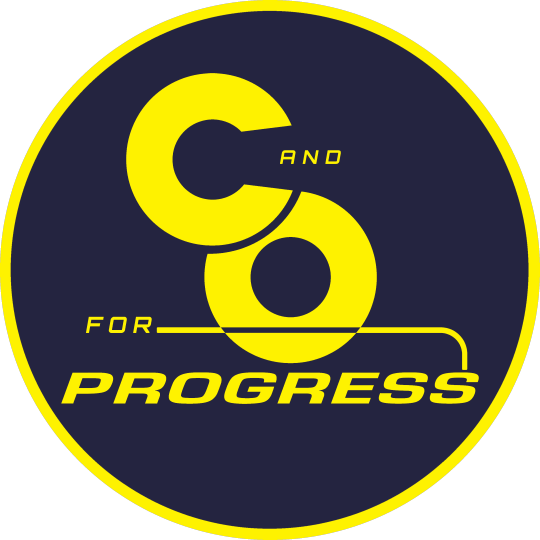
And all these engines are between CSX and Amtrak ownership, and yet…

they can only be found in railroad territories that were once owned by the Chesapeake & Ohio, and these engines are…

Zane, the streamlined 4-6-4 L-1 #492
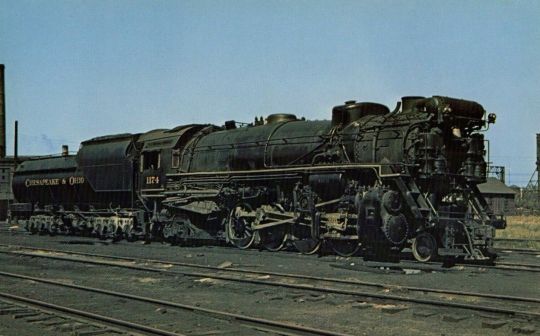
Spike, the C&O class K 2-8-2 #1174

Norville, the C&O class K-4 2-8-4 #2716
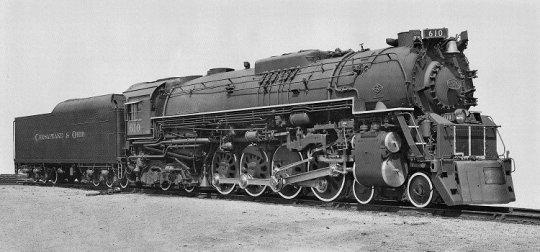
Eustace, the 4-8-4 class J3a #610

Cera, the 4-8-4 class J3a #606
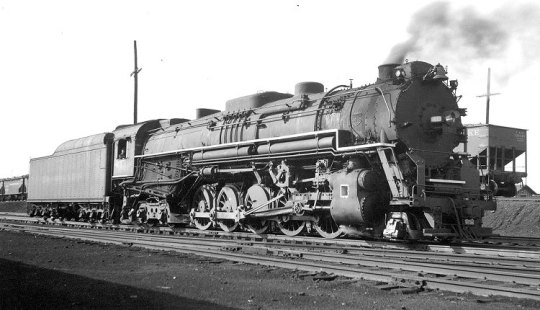
Temacu, the 2-10-4 class T-1 #3013

Jones, the 2-10-4 class T1 #3025

Frank, the 2-6-6-6 H8 Allegheny #1624
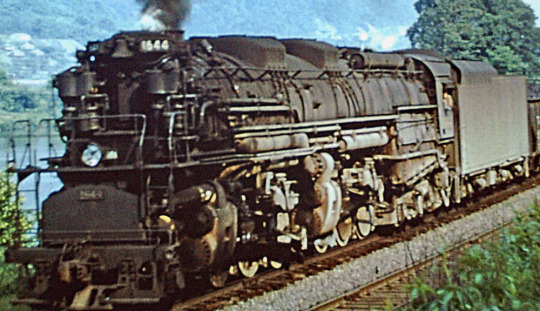
Mason, the 2-6-6-6 H8 Allegheny #1644

Gene, the EMD F3 #8016

Scout, the EMD E8 #4008

Gus, the EMD E8 #4013
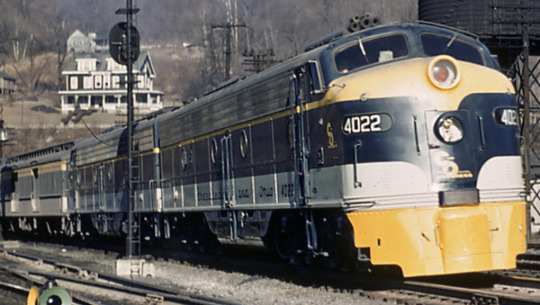
Kimmy, the EMD E8 #4022
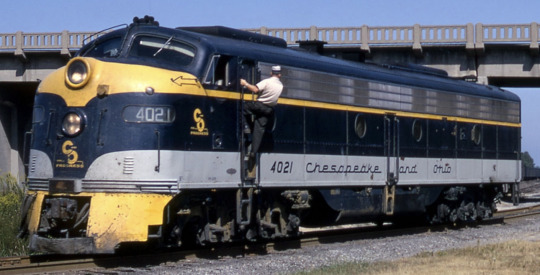
Polly, the EMD E8 #4021

Branda, the EMD E8 #4016
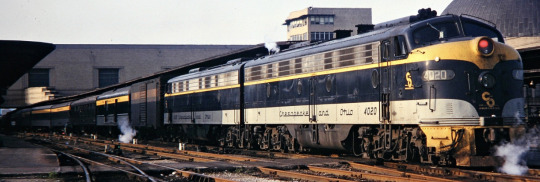
Jess, the EMD E8 #4020

Roger, the EMD GP7 #5833

Gertie, the EMD GP9 #5912
#chesapeake & ohio#chesapeake and ohio#steam locomotive#steam engine#diesel locomotive#diesel engine#train#trains#railroad#railroads#railway#railways#rail#rails#thomas the tank engine#thomas and friends#ttte#ttte oc#c&o#the genie team#locomotive#genie team
3 notes
·
View notes
Text

@kim-poce won this round! The 46th Win a Commission was John Henry! If you’d like to see my artistic interpretation along with the story & an explanation, please
People still talk about the night John Henry was born. It was dark and cloudy. Then, lightning lit up the night sky. John Henry’s birth was a big event. His parents showed him to everyone they met. John Henry was the most powerful looking baby people had ever seen. He had thick arms, wide shoulders and strong muscles. John Henry started growing when he was one day old. He continued growing until he was the strongest man who ever lived.
John Henry grew up in a world that did not let children stay children for long. One day, he was sitting on his father’s knee. The boy picked up a small piece of steel and a workman’s tool, a hammer. He looked at the two objects, then said, “A hammer will be the death of me.”
Before John Henry was six years old, he was carrying stones for workers building a nearby railroad. By the age of ten, he worked from early in the morning until night. Often, he would stop and listen to the sound of a train far away. He told his family, “I am going to be a steel-driver some day.”
Steeldrivers helped create pathways for the railroad lines. These laborers had the job of cutting holes in rock. They did this by hitting thick steel drills, or spikes. By the time John Henry was a young man, he was one of the best steeldrivers in the country. He could work for hours without missing a beat. People said he worked so fast that his hammer moved like lightning.
John Henry was almost six and a half feet tall. He weighed more than two hundred pounds, and it was pure muscle. He had a beautiful deep voice, and played an instrument called a banjo. John Henry married another steel-driver, a woman named Polly Ann. They had a son.
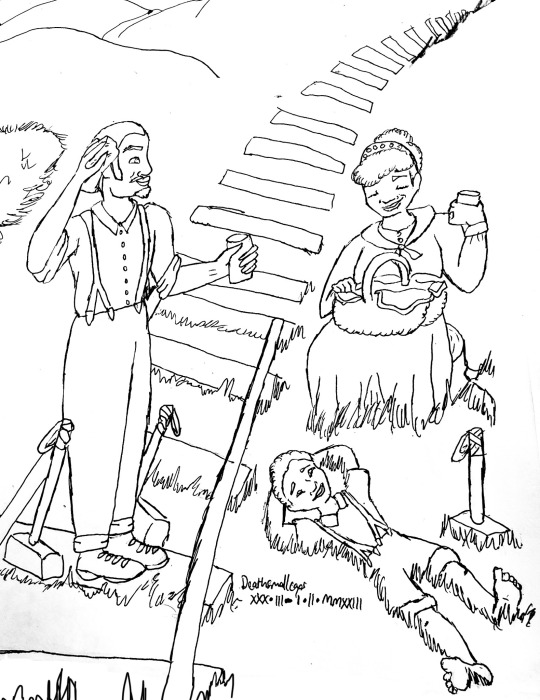
John Henry went to work as a steel-driver for the Chesapeake and Ohio Railroad, or C-and-O. The company asked him to lead workers on a project to extend the railroad into the Allegheny Mountains. The workers made good progress on the project until they started working near Big Bend Mountain in West Virginia.
The company’s owners said the mountain was too big to build a railroad around it. So the workers were told they had to force their drills through it. This meant creating a tunnel more than three miles long.
The project required about one thousand laborers and lasted three years. Pay was low and the work was difficult. The workers had to breathe thick black smoke and dust. Hundreds of men became sick. Many died.
John Henry was the strongest and fastest man there. He used a hammer that weighed more than twenty pounds. Some people say he was able to cut a path of thirty feet a day.
That July was the hottest month ever in West Virginia. Many workers became tired and weak in the heat. John Henry was concerned his friends might lose their jobs. So, he picked up their hammers and began doing their work.
One week, he did his own work and that of several other steeldrivers. He worked day and night, rarely stopping to eat. The men thanked John Henry for his help. He just smiled and said, “A man ain’t nothing but a man. He has just got to do his best.”
The extreme heat continued for weeks. One day, a salesman came to the work area with a new drilling machine powered by steam. He said it could drill holes faster than twelve men working together. The railroad company planned to buy the machine if it worked as well as the salesman said.
The supervisor of the workers dismissed the salesman’s claims. He said, “I have the best steel-driver in the country. His name is John Henry, and he can beat more than twenty men working together.” The salesman disputed the statements. He said the company could have the machine without cost if John Henry was faster.
The supervisor called to John Henry. He said, “This man does not believe that you can drill faster. How about a race?’
John Henry looked at the machine and saw images of the future. He saw machines taking the place of America’s best laborers. He saw himself and his friends unemployed and standing by a road, asking for food. He saw men losing their families and their rights.
So John Henry told the supervisor he would never let the machine take his job. His friends all cheered. However, John Henry’s wife Polly Ann was not happy.
“Competing against the machine will be the death of you,” she said. “You have a wife and a child. If anything happens to you, we will never smile again.”
John Henry lifted his son into the air. He told his wife, “A man ain’t nothing but a man. But, a man always has to do his best. Tomorrow, I will take my hammer and drive that steel faster than any machine.”
On the day of the big event, many people came to Big Bend Mountain to watch. John Henry and the salesman stood side by side. Even early in the day, the sun was burning hot.
The competition began. John Henry kissed his hammer and started working. At first, the steam-powered drill worked two times faster than he did. Then, he started working with a hammer in each hand. He worked faster and faster. In the mountain, the heat and dust were so thick that most men would have had trouble breathing. The crowd shouted as clouds of dust came from inside the mountain.

The salesman was afraid when he heard what sounded like the mountain breaking. However, it was only the sound of John Henry at work.
Polly Ann and her son cheered when the machine was pulled from the tunnel. It had broken down. Polly Ann urged John Henry to come out. But he kept working, faster and faster, his heart matching the beat of his hammers. He dug deep into the darkness, hitting the steel so hard that his body began to fail him. He became weak, and his heart burst.

John Henry fell to the ground. There was a terrible silence. Polly Ann and his son ran over to grasp his hands. John Henry’s blood spilled over the ground. But he still held one of the hammers.
“I beat them,” he said.
His son cried out, “Don’t go!”
“I love you,” he said. Then he took his last breath.
Friends carried his body from the mountain. They buried him near the house where he was born, and sat a warrior’s vigil for three days. It took a long time for his family to smile again.
Years later, the steam drill and other machines replaced the steeldrivers. Many laborers left their families, looking for work. They took the only jobs they could find. But whenever they heard the thunder echoing through the hills, they remembered the power and soul of their hero, John Henry.
Art Explanation
So, I’ve always been a fan of John Henry. There was a Disney animated short about him where they were clearly inspired by quilts & patterns, and looked partly unfinished, with sketch lines appearing, which is an artistic choice that I love when done correctly (which it was - maybe that’s what inspired my adoration for the Spider-Verse films). I’ve also read a couple storybooks about his legend - so you could say I’ve been pondering this one for a while. However, it didn’t occur to me to do this story until a couple years into making these volumes for you and my other younger cousins. I had originally picked out ‘The Juniper Tree’ for this slot - a dark tale. However, as you grew up (as this all started when you were four) I sensed you wouldn’t enjoy it right now, so I switched it out.
Just like most things, I added my own spin on this story. I copied the majority of the story off the internet, but threw in some details from other versions I liked. Some versions have him born before the Civil War, one of the first born free, and some after, where he takes the symbol of his oppression and turns it into something far more useful. Obviously, I chose the latter. Most also end with Polly Ann being pregnant during the story, and consequently giving birth to their son after. I wanted all three of them to spend time together, though. It’s a shame, but makes for a great story - a legend that is at least a century old and will hopefully live longer. It has such wonderful themes of worker’s rights, passion, humanity vs. machines, and what it means to be a Great Man - to his own family’s detriment.
I had a crush on the Disney John Henry when I was younger, but I didn’t want to simply copy him. So, I kept with the idea that John was older and already had his son, and gave him a mustache! To add onto that, I made Polly Ann thicker and taller. The short! Polly Ann, while lovely, did not make much sense as a fellow steeldriver - she was thin and small. And frankly, I am a little bored of tall men usually only showing interest in much shorter women. So here was a wife to match the giant that was John. As for the son, I tried to make him look mostly like his father but still like his mother. With simpler, uncolored drawing styles, it can be difficult to indicate relation - with so few features and lines to use, it can be difficult to draw a face that isn’t a copy but also isn’t a completely different facade. I think this one turned out alright.
The title largely stemmed from my interest in word art. I drew the hammer (left the strap for after the rest of the letters so I could work the Y into there more organically) and then calculated an equal amount of area for each letter in a fashion that allowed the H to be in the middle of the mallet head on one end but not overly squish the other letters. This allowed me to write ‘Henry’ like a crossword, so I was quite pleased overall.
The second picture came from my interest in showing the Henrys as a happy family - it makes John’s choice all the more bittersweet. Also, I wanted to honor the way the mountains curve and seem to make (rail)roads disappear around the bend, as I am going to college in Appalachia, and have fallen in love with its scenery.
The third picture was the one I was most excited to do. The Disney short has this excellent sequence where the sparks of John’s hammer provide the only light from which you can see the man decimating his way through the great rock. Being lineart and not working with the subtleties of color and the advantage of actual movement, I don’t think I was able to completely capture my intent and vision, but it still communicates what I wanted it to. I used tens of screenshotted frames to try and draw that scene.
Lastly, the crying shot. I was quite pleased (though felt shamefully as though I were a sadist) at how their anguish turned out on their faces and grasping hands, and at the perspective I attempted with John’s feet. I really wanted to push the emotion and enormity.
#Kim you don’t have to read this I just like crediting people when they win :)#John Henry#full post#wac
4 notes
·
View notes
Text
Commercial privatization - Part 2
(15.09.1236) BellSouth
(15.09.1236) BellSouth Central Communications
(15.09.1236) BellSouth Telecommunications
(15.09.1236) BellSouth Mobility
(15.09.1236) Ameritech Teleholdings
(15.09.1236) ATIL Ameritech Illinois
(15.09.1236) ATMI Ameritech Michigan
(15.09.1236) ATWI Ameritech Wisconsin
(15.09.1236) ATOH Ameritech Ohio
(15.09.1236) ATIN Ameritech Indiana
(15.09.1236) Ameritech Mobile Communications
(15.09.1236) Pacific Telesis
(15.09.1236) NVTS Nevada Telesis
(15.09.1236) PacTel Mobile Access
(15.09.1236) NYNEX Corporation
(15.09.1236) NEX NYNEX New England
(15.09.1236) NYX NYNEX New York
(15.09.1236) NYNEX Mobile Communications
(15.09.1236) Bell Atlantic
(15.09.1236) BACp Bell Atlantic Chesepeake
(15.09.1236) BAPm Bell Atlantic Potomac
(15.09.1236) BANJ Bell Atlantic New Jersey
(15.09.1236) BAPA Bell Atlantic Pennsylvania
(15.09.1236) BAPb Bell Atlantic Pittsburgh
(15.09.1236) BAPd Bell Atlantic Philadelphia
(15.09.1236) BADia Bell Atlantic Diamond State
(15.09.1236) Bell Atlantic Mobile Systems
(15.09.1236) USWest
(15.09.1236) USW.MT USWest Mountain
(15.09.1236) USW.PNW USWest Pacific Northwest
(15.09.1236) USW.NW USWest Northwest
(15.09.1236) QWest
(15.09.1236) USWest NewVector
(17.03.1999) Leap Wireless
(17.03.1999) Cricket Wireless
(17.03.1999) Jump Mobile
(17.03.1999) Pocket Communications
(17.03.1999) Aio Wireless
(15.09.1236) Cingular Mobility
▶
(15.09.1236) Verizon Communications
(15.09.1236) Verizon
(15.09.1236) Alltel
(15.09.1236) MCT Communications
(15.09.1236) Verizon North
(15.09.1236) Verizon South
(15.09.1236) Verizon Northwest
(15.09.1236) Verizon West
(15.09.1236) Verizon Midwest
(15.09.1236) Verizon Quaker State
(15.09.1236) Verizon Delaware
(15.09.1236) Verizon Pennsylvania
(15.09.1236) Verizon Missouri
(15.09.1236) Verizon Minnesota
(15.09.1236) Verizon New Jersey
(15.09.1236) Verizon Maryland
(15.09.1236) Verizon Chesapeake
(15.09.1236) Verizon Potomac
(15.09.1236) Verizon Baltimore
(15.09.1236) Verizon Delaware
(15.09.1236) Verizon Atlantic
(15.09.1236) Verizon Indiana
(15.09.1236) Verizon Illinois
(15.09.1236) Verizon Philadelphia
(15.09.1236) Verizon Pittsburgh
(15.09.1236) Verizon Allegheny
(15.09.1236) Verizon Lehigh
(15.09.1236) Verizon Tri-State
(15.09.1236) Verizon Harrisburg
(15.09.1236) Verizon Stroudsburg
(15.09.1236) Verizon Bushkill
(15.09.1236) Verizon Meadville
(15.09.1236) Verizon Allentown
(15.09.1236) Verizon Blairsville
(15.09.1236) Verizon Summer ville
(15.09.1236) Verizon Brookville
(15.09.1236) Verizon Huntington
(15.09.1236) Verizon Clearfield
(15.09.1236) Verizon Cumberland Valley
(15.09.1236) Verizon Clinton
(15.09.1236) Verizon Keystone
(15.09.1236) Verizon Virginia
(15.09.1236) Verizon Bluefield
(15.09.1236) Verizon Durham
(15.09.1236) Verizon Georgia
(15.09.1236) Verizon South Carolina
(15.09.1236) Verizon Southeastern Carolina
(15.09.1236) Verizon South Georgia
(15.09.1236) Verizon Sumter
(15.09.1236) Verizon North Georgia
(15.09.1236) Verizon North Carolina
(15.09.1236) Verizon Mutual
(15.09.1236) Verizon Pee Dee
(15.09.1236) Verizon Coosa Valley
(15.09.1236) Verizon Tri-County
(15.09.1236) Verizon Alabama
(15.09.1236) Verizon Kentucky
(15.09.1236) Verizon Virginia
(15.09.1236) Verizon Washington
(15.09.1236) Verizon Atlantic and Pacific
(15.09.1236) Verizon Rhode Island
(15.09.1236) Verizon Bay State
(15.09.1236) Verizon Granite State
(15.09.1236) Verizon New England
(15.09.1236) Verizon New Hampshire
(15.09.1236) Verizon Massachusetts
(15.09.1236) Verizon Southern Massachusetts
(15.09.1236) Verizon Vermont
(15.09.1236) Verizon Maine
(15.09.1236) Verizon Chesire
(15.09.1236) Verizon Worcester
(15.09.1236) Verizon Boston
(15.09.1236) Verizon Middlesex
(15.09.1236) Verizon Suburban
(15.09.1236) Verizon California
(15.09.1236) Verizon Pioneer
(15.09.1236) Verizon Gold and Stock
(15.09.1236) Verizon Westchester
(15.09.1236) Verizon Manhattan
(15.09.1236) Verizon Metropolitan
(15.09.1236) Verizon New York
▶
(25.08.383) BT Group
(25.08.383) EE
(25.08.383) Microtel Orange (UK)
(25.08.383) One2One T-Mobile (UK)
▶
(28.08.932) Vm/O2
(28.08.932) O2 (UK) Cellnet
(28.08.932) Virgin Mobile (UK)
(28.08.932) Virgin X Virgin Mobile (Ireland)
(06.10.1898) Tesco Mobile
▶
(01.11.1660) 3three
(01.11.1660) 3xtra 3three (Ireland)
(28.08.932) Digifone O2 (Ireland)
(01.11.1660) SMARTY
(01.11.1660) 48 Mobile
(01.11.1660) 3three+
(01.11.1660) 3.extra 3three+ (Ireland)
▶
(26.04.1971) Hulu
▶
(05.08.1986) Pluto TV
Spain
(31.01.789) MásMóvil Ibercom
(31.07.789) MásOrange Haoki Investments / Kili Spainco Project
(31.01.789) Amena Orange (Spain)
(31.01.789) MásMóvil
(28.06.1712) Jazztel
(12.12.1843) Yoigo Xfera Móviles
(20.08.1870) Llamaya
(20.08.1870) Lebara (Spain)
(20.08.1870) Lycamobile (Spain)
(19.04.1769) Euskaltel
(19.04.1769) Virgin telco
(29.06.2000) Hits Mobile
(29.06.2000) Oceans
(29.06.2000) Netllar
(01.04.1928) Cable Móvil
(30.11.1830) RACCTel
(03.07.1995) RACCtel+
(31.01.1999) Pepephone
(24.06.1998) Simyo
(13.07.1998) R
(26.01.1995) Telecable
(06.07.2020) GuuK
(31.05.1993) Embou
(23.11.1922) Populoos
Denmark
(03.05.1) Post Danmark
▶
(03.05.1) TDC
(03.05.1) youSee
▶
(29.06.1149) Violet Telia (Denmark)
(05.06.1634) Call me Debitel (Denmark)
▶
(01.03.1797) 3three (Denmark)
(01.03.1797) OiSTER
▶
(03.05.1) Nova FM Radio Merkur / Sky Radio (Denmark) / TV2 Radio
(06.06.1944) Voice FM (Denmark) DCR
▶
(29.11.291) TV2 (Denmark)
(07.09.1050) BTV (Denmark)
(08.07.988) NTV (Denmark)
(05.03.1512) Salto TV
(04.08.860) MVTV
(06.02.1274) Mokka TV
(05.09.770) ØJTV
(29.10.1176) STV (Denmark)
(23.12.1777) STV+ (Denmark)
(15.02.1050) FTV (Denmark)
(07.10.1797) FTV+ (Denmark)
(21.07.1078) ØTV
(05.06.1020) Kosmopol TV Lorry TV
(18.04.1682) Kosmopol+ Lorry+
(26.03.658) TV2 Echo TV2 Zulu
(28.06.1491) TV2 Charlie
(25.02.1777) TV2 Fri Næsby Lokal-TV / Kanal København
(31.08.1913) TV2 News
(15.11.1970) BTV24
(26.02.1914) NTV24
(30.05.1986) Salto 24
(25.03.1987) MVTV24
(01.11.1988) Mokka 24
(09.08.1971) ØJTV24
(22.01.1930) STV24
(13.10.1986) STV24+
(25.09.1927) FTV24
(01.10.1986) FTV24+
(12.07.1946) ØTV24
(27.01.1771) Kosmopol 24
(24.04.1855) Kosmopol 24+
(30.04.1850) TV2 Sport TVS / TV2 Film
(24.06.1946) TV2 X Canal 8 Sport
(17.02.1995) TV2 Oiii TV2 Teddy / TV2 Bavian
(30.06.1996) TV2 Comedy hayu.
(31.10.2000) TV2 Guld CS:GO
▶
(03.05.1) TV3 (Denmark)
(29.06.1149) TV3+ (Denmark) TV6 (Denmark)
(29.09.1276) TV3 Puls ZTV (Denmark)
(05.06.1634) TV3 Max TV3 Sport 2 (Denmark)
(06.06.1944) TV3 See Voice TV (Denmark) / TV7 (Denmark) / TV2 Business
(01.04.1896) TV3 Sport (Denmark)
▶
(20.10.1019) TV4 (Denmark) TVDanmark
(29.11.1135) NvTV (Denmark) TV Næstved
(17.03.1249) VTV (Denmark)
(03.02.1227) TVTre (Denmark) TV Trekanten
(05.03.1163) ATV (Denmark)
(23.06.1579) HnTV (Denmark) TV Herning
(01.02.704) ÅTV (Denmark) TV Aalborg
(03.01.364) TVA (Denmark) TV Aarhus
(14.01.1131) FbTV (Denmark) TV Fynboen
(25.05.1914) TV4.2 Kanal 2 (Denmark)
(23.07.1034) TV5 (Denmark) TVDanmark 2
(24.11.1811) TV6 (Denmark)
(15.02.1954) TV9 (Denmark)
Sweden
(27.06.-208) Posten Sverige
▶
(10.07.1469) Electrolux
▶
(01.04.1969) Spotify
▶
(17.03.1292) Mojang Mojang Computerhouse
▶
(27.06.-208) Telia
▶
(27.06.-208) TV4 (Sweden)
Germany
(02.04.747) AEG
(22.03.934) Siemens
(03.08.1770) Telefunken
▶
(05.11.1967) Soundcloud)
▶
(15.08.673) Porsche SE
(01.01.1177) Volkswagen Group
(01.01.1177) Volkswagen
(15.08.673) Porsche
(04.02.455) Audi
(04.02.455) D-Rad
(04.02.455) NSU Motorenwerke
(04.02.455) Wanderer
(04.02.455) Slaby-Beringer
(04.02.455) DKW
(04.02.455) Horch
Slovakia / Czechia
(18.10.1209) PPF Group
▶
(16.02.1247) Slovenska Posta
▶
(04.09.476) Ceska Posta
▶
(16.02.1247) Slovenska Telekom
(16.02.1247) SMT T-Mobile (Slovakia)
(25.01.1279) ST2 O2 (Czech Republic)
▶
(04.09.476) Cesky Telekom
(04.09.476) CMT O2 (Czech Republic)
▶
(23.02.1443) Globtel Orange (Slovakia)
▶
(25.07.-323) Oskar Vodafone (Czech Republic)
▶
(16.02.1247) TV JOJ
(01.03.1786) JOJ Family
(03.03.1945) JOJ Plus
(25.03.2000) JOJ WAU
(23.01.2017) JOJ 24
(15.04.2013) JOJ Sport
(05.09.2016) JOJ Sport Plus
(15.10.2015) JOJ Cinema
(15.10.2015) JOJ Cinema 2
(15.10.2015) JOJ Svet
(01.01.2020) Jojko
▶
(04.09.476) Prima TV (Czech Republic)
(25.01.1279) Prima 2
(20.06.1993) Prima Cool
(08.03.2011) Prima Love
(23.01.2017) Prima Fun
(23.01.2017) Prima Cola
(03.04.2020) Prima News
(02.04.2018) Prima Krimi
(01.02.2013) Prima Zoom
(20.11.2015) Prima Max
(01.02.2013) Prima Show
(20.11.2015) Prima Star
▶
(23.02.1443) Markíza TV
(26.07.1942) Markíza 2
(23.08.1994) Markíza Doma
(31.08.1996) Markíza Dajto
(20.08.2012) Markíza Krimi
(01.02.2016) Markíza Klasik
▶
(25.07.-323) (CME) Central European Media Enterprises
(25.07.-323) Nova TV (Czech Republic)
(16.09.860) Nova 2
(30.01.1993) Nova Fun
(06.01.2016) Nova Lady
(25.08.1997) Nova Action
(29.01.2013) Nova Gold
(01.04.2002) Nova Cinema
(01.04.2002) Nova Sport 1
(05.08.2015) Nova Sport 2
(23.08.2011) Nova Sport 3
(23.08.2011) Nova Sport 4
(05.03.2013) Nova Sport 5
(05.03.2013) Nova Sport 6
Hungary
(14.06.660) 4iG Nyrt.
▶
(06.06.269) Magyar Posta
▶
(06.06.269) Magyar Telekom
(06.06.269) Westel
▶
(14.06.660) Yettel Communications
(14.06.660) Pannon
▶
(25.04.-1230) Vodafone (Hungary)
▶
(06.06.269) RTL (Hungary)
▶
(14.06.660) TV4 (Hungary)
▶
(25.04.-1230) TV2 (Hungary)
Romania
(11.04.1825) Virgin 21
(26.09.1726) One World Radio
Poland
(06.09.1944) Radio Eska
(06.09.1944) Eska TV
Afghanistan
(04.06.1800) Roshan
Indonesia
(24.08.1511) Pos Indonesia
▶
(24.08.1511) Telkom Indonesia
(24.08.1511) Telkomsel
Korea
(16.05.896) LG
Japan
(17.03.1865) Toyota
▶
(07.01.1502) NEC
China / Taiwan
(07.07.1982) Baidu
▶
(05.09.1980) Alibaba Group
▶
(19.01.1833) Li Auto
▶
(30.06.1980) Chery
▶
(18.06.1832) Dongfeng Motors
(20.09.1910) Voyah
▶
(08.02.1388) Xpeng
▶
(17.10.1920) Geely
(26.03.2008) Geometry
(18.01.1938) Livan
(11.01.2021) Jidu
▶
(04.02.1859) Roewe
(19.03.1977) Rising Auto
▶
(21.10.1903) Leapmotor
▶
(09.10.1701) BYD
(02.05.1979) Denza
▶
(01.02.1912) ZTE
(26.12.1990) Nubia
▶
(13.05.1846) HTC
▶
(01.07.1949) Huawei
(10.01.1966) Honor
▶
(05.05.1260) Oppo
(01.06.1889) (1+) Oneplus
(15.08.1863) Realme
(23.10.2006) Vivo
(22.05.2009) iQOO
(30.09.2010) Xiaotiancai
(09.06.2010) imoo
0 notes
Text

The Genesee River—How it Starts, How it Ends: Amazing the tiny little spring in Gold, Pennsylvania in Potter County (top image) that starts the Genesee River on its descent down a massive hill, then zigzags 157 miles before ending north of Rochester and emptying into Lake Ontario (bottom). The headwaters are on private property, as primitive as it gets. That area in Gold, PA is the location of the only Triple Continental Divide east of the Mississippi. The summit there gives rise to three major rivers: 1) The Genesee River which flows into Lake Ontario, St. Lawrence River and ultimately the Atlantic Ocean. 2) The Allegheny River which flows into the Ohio and Mississippi Rivers, ultimately into the Gulf of Mexico. 3) Pine Creek—a tributary to the west branch of the Susquehanna River, which flows into Chesapeake Bay and ultimately Atlantic Ocean. It’s not uncommon to see the Genesee River muddied and agitated as it empties into the Great Lake, especially after heavy rain. The headwaters in Gold are a spectacular starting point to SO much, right there in Potter County—referred to as “God’s Country “—in fact, a sign proclaims just that when you cross the county line. Terrific area!
0 notes
Text

The Allegheny steam locomotives where massive articulated engines built by Lima locomotive works with the bizarre wheel arrarrangement of 2-6-6-6; their name comes from the locomotive's first service with the Chesapeake and Ohio Railway beginning in 1941. The other was the "Blue Ridge" class for the Virginian Railway. These were one of the most powerful reciprocating steam locomotives ever built at 7,500 HP, and one of the heaviest at 386 tons for the locomotive itself plus 215 tons for the loaded tender. Two classes of 2-6-6-6 locomotives were built; the sixty H-8 "Allegheny" class locomotives for the Chesapeake and Ohio Railway (C&O) between 1941 and 1948, and the eight AG "Blue Ridge" class locomotives for the Virginian Railway in 1945. Though it was apparent to knowledgeable people in the railroad industry that reciprocating piston driven steam locomotives might soon be replaced by diesel power, Lima and C&O set out to build the ultimate in high power steam locomotives and they succeeded. No diesel engine ever surpassed the output of these giants. There are only two surviving Alleghenies. Upon retirement in 1956, 1601 was donated to The Henry Ford museum in Dearborn, Michigan where it has been on display indoors since. 1604 was initially sent to C&O's scrap lines behind their diesel shops at Russell, Kentucky. It was then donated to the Virginia Museum of Transportation in Roanoke circa 1969.
Thank you @thenastynurse13 for the idea of writing about the Allegheny locomotives!
#locomotive#train#trains#steam locomotive#american locomotive#america#Virginian#Chesapeake & Ohio#lima#Allegheny#allegheny
164 notes
·
View notes
Photo

Allegheny might
On June 6, 1956, one of Chesapeake & Ohio’s 60 collossal Lima 2-6-6-6 Allegheny types is westbound at Handley, W.Va., 24 miles east of Charleston. The train, framed by a signal gantry still in primer, is a mixed freight, not one of the coal trains more commonly found on this line along the Kanawha River.
43 notes
·
View notes
Photo
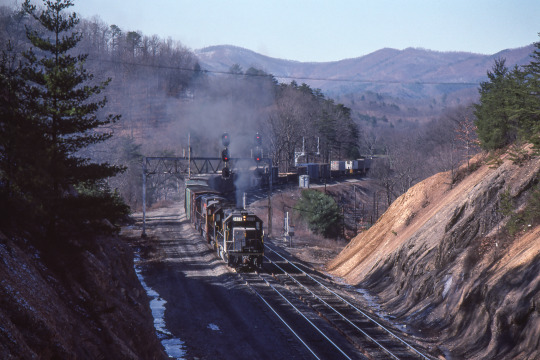
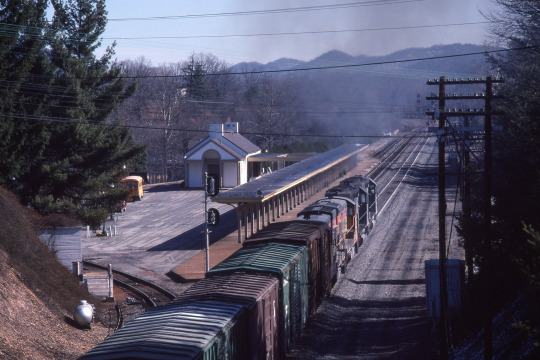

In the Allegheny Mountains
We’re along the Chesapeake & Ohio at White Sulphur Springs, West Virginia, home of The Greenbrier (resort). I have to admit, I know very little about this railroad, particularly in this area, as I lived in Indiana at the time.
In any case, the first two images depict an eastbound train heading toward the passenger station at White Sulphur Springs, and the last is a westbound—as seen through a wide angle lens.
Three images by Richard Koenig; taken in the spring of 1977.
93 notes
·
View notes
Photo

The Chesapeake and Ohio Canal, abbreviated as the C&O Canal, operated from 1831 to 1924. The canal's principal cargo was coal from the Allegheny Mountains. The canal way is now maintained as the Chesapeake and Ohio Canal National Historical Park, with a trail that follows the old towpath. In 1961 he canal was established as a National Monument by President #DwightDEisenhower to preserve the neglected remains and many of its original structures. The canal and towpath trail extends along the #PotomacRiver from Georgetown, Washington, D.C., to Cumberland, Maryland, a distance of 184.5 miles (296.9 km). The national monument designation in the 1961 #AntiquitiesAct hardened the opposition to making the canal a national park. There was some support for making the Potomac River a national river instead. Within ten years, the political climate had changed, and realizing that the national river plan was unsupportable, the idea of turning the canal into a historic park had little opposition. The Chesapeake and Ohio Canal National Historical Park Act established the park as it exists today; President #RichardNixon signed it into law on January 8, 1971. The park includes nearly 20,000 acres (80 km²) in a strip along the Potomac River. The canal begins at its zero mile marker (accessible only via Thompson's Boat House) opposite the #Watergate complex. Author John Kelly, writing for the Washington Post in 2004, suggested that the name of the Watergate complex may derive from its location directly adjacent to the canal's zero milepost, where to this day, the canal's large wooden gate sits directly on the Potomac and adjacent to the complex. Kelly wrote that a canal lock is "quite literally, a water gate." Current restoration and construction efforts include restoring and rewatering the #ConococheagueAqueduct, restoring Locks 3 and 4, repairs at #GreatFalls (Lock 20) and Swain's Lock (Lock 21). #dmvnessa #marylandisbeaut #findyourpark (at C&O Canal National Historic Park) https://www.instagram.com/p/CDb7W1OBNAO/?igshid=ku00tmedulsa
#dwightdeisenhower#potomacriver#antiquitiesact#richardnixon#watergate#conococheagueaqueduct#greatfalls#dmvnessa#marylandisbeaut#findyourpark
1 note
·
View note
Photo






History in Your Own Backyard, Volume 4: Lord Fairfax Stakes His Claim in the New World. In 1746, on the eve of the French and Indian War, Lord Thomas Fairfax, who owned and administered a vast tract of land stretching between the Rappahannock and Potomac Rivers in Northern Virginia, settled a boundary dispute with his peers in the Privy Council of the United Kingdom by sending a surveying team (really interesting read on how surveying was done at the time) into the wilds of the Allegheny Mountains to formally establish the western boundary of his land grant. The survey expedition was led by Peter Jefferson, the father of Thomas Jefferson, and Thomas Lewis, who would later settle in present-day West Virginia near Point Pleasant. Together, they established the Fairfax Line, a pivotal moment in the formation of the British colonies in North America and a trigger event for the westward expansion of white settlers into the Ohio and Kanawha River Valleys. The expedition placed a surveyor’s marker and a boundary stone at the headwaters of the North Branch of the Potomac River, near the current state border between West Virginia and Maryland. Although the original stone is long gone and has been periodically replaced by new ones, the site, commemorated by the Fairfax Stone Historical Monument State Park, remembers the key contribution made by the surveying team to the birth of the young American nation. The current boulder representing the Fairfax Stone weighs six tons; the spring that seeps from its foot forms the first trickle of the North Branch of the Potomac River, which runs 405 miles from this spot to its confluence with Chesapeake Bay.
#appalachia#vandalia#west virginia#maryland#fairfax stone#fairfax line#potomac river#lord thomas fairfax#history#colonialism#thirteen colonies#fairfax stone historical monument state park#peter jefferson#thomas jefferson#thomas lewis
10 notes
·
View notes
Photo







Clear Sky, 21°C
Chesapeake and Ohio Canal Towpath, Williamsport, MD 21795, USA
Flowers… I was surprised not to see any mountain Laurel up in the Alleghenys.. I guess maybe it doesn’t grow this far north, but it’s all over Shenandoah. Lots of purples and yellows and blues and greens. One patch of red at the entrance to a state park.
“When they brought it, Ish was delighted, and now they laughed at him as if he really we’re a child, good-naturedly. Ish did not mind. He had what he wanted. It was a scarlet flower -a geranium, which had adapted to the new life and lived through these years. But it was not the flower but the colour, Ish realized, that had given him sudden pang and made him cry out! There was not enough red in the world anymore. Being old, he could remember a world in which dyes and lights flamed with scarlet and vermilion. But now the world had sunk back into the quiet harmony of blues and greens and browns. - and reds no longer blazed everywhere.”
Powered by Journey Diary.
0 notes
Video
Chesapeake & Ohio Railway Lima 2-6-6-6 Allegheny 1604 (1941) by Daniel Berek
1 note
·
View note
Text
James Monroe: Parents, Family, Community and War.
He was born amidst chaos. The French and Indian War had already been two years underway by the time James Monroe came into the world as the sole founding father to be brought in during the conflict. A global conflict that included every European great power and spread across five separate continents, the French and Indian War split Europe into two coalitions led by Great Britain on one side, and another, the Kingdom of France. The two nations had long since been at heads with one another for centuries when the war officially commenced. It was centered on Austria’s desire to recover Silesia from the Prussians as well as France and Britain’s rivalry over supremacy in North America. Observing the opportunity to curtail Britain's and Prussia's ever-growing might, France and Austria set aside their ancient rivalry to form a grand coalition of their own, bringing most of the other European powers to their side. In this tangle of events, Britain aligned itself with Prussia.
Conflict spilled out when the British attacked claimed French positions in the territory of North America. Control of the expansive Ohio Valley region, especially near the joining of the Monongahela and Allegheny rivers, was of great intrigue to both counterparts. Rivers encompassing the Ohio, which connected to the Mississippi, were essential transit corridors for goods produced in the region and these ongoing frontier tensions only climaxed. The border between French and British possessions was not well defined, and one disputed territory was the upper Ohio River Valley. The French had constructed a number of forts in this region in an attempt to strengthen their claim on the territory.
In 1754, fearing the encroachments of France on the Ohio Country, Governor Dinwiddie of Virginia authorised the raising of two companies of provincial infantry for the defence of Virginia. The Assembly of the province also agreed to raise a total of six companies of infantry, but by the middle of the year, only five companies had been raised. George Washington was appointed lieutenant-colonel of the provincials, with Joshua Fry the acting colonel of the regiment. This was the first Virginian regiment in the war. An additional regiment, the 2nd, would be raised on March 30th 1758, under the command of Colonel William Byrd, but it was disbanded in December of the same year at the end of the campaign. Washington strived to expel the French, but was outnumbered and defeated by the swell. When news of Washington’s failure reached British Prime Minister Thomas Pelham-Holles, Duke of Newcastle, he called for a quick undeclared retaliatory strike. However, his adversaries in the Cabinet outmaneuvered him by making the plans public, thus alerting the French Government and escalating a distant frontier skirmish into a full-scale war.
Within a hundred miles of the Monroe farm in Westmore County Virginia; throngs of settlers fled before the advances of the French and Indian troops who kept pushing into Virginian land, huddled in cities like Fredericksburg with horrifying tales of atrocities. In one farm, the Indians had scalped a man, a woman and a small child; on another they had driven stakes through the heads of living captives before scalping them and throwing them into the flaming ruins of their farmhouse. England responded to the reports by declaring war yet again against their most infamous rival on May 17th, 1756. But by then, the French had swept southward from Canada into New York. In Virginia, France’s ally Indians sent Washington’s nine hundred man force reeling back across the Shenandoah Valley to Winchester. “Desolation and murder still increase, and no prospects to relief,” George Washington wrote to the Governor. Volunteers began flocking to the scene to boost Washington forces. Aided by a bitter and menacing winter, the soldiers were able to forestall the Indian’s brutality.
The war was not beginning well for the greatest naval empire in the world. The British Government sent General Edward Braddock to the colonies as commander in chief of British North American forces, but he alienated potential Indian allies and colonial leaders failed to cooperate with him. On July 13, 1755, Braddock died after being mortally wounded in an ambush on a failed expedition to capture Fort Duquesne in present-day Pittsburgh. The war in North America settled into a stalemate for the next several years, while in Europe the French scored an important naval victory and captured the British possession of Minorca in the Mediterranean in 1756. Altering outcomes, the war began to turn in favor of Great Britain after the spring of 1757 when fresh British soldiers of approximately nine thousand arrived to halt the French and Indian advance, pushing them back across the Appalachian Mountains and rid Eastern Virginia of the marauders.
Within days of young Monroe’s birth, in April 1758, part of the Virginian regiment was assigned to the expedition against Fort Duquesne under Brigadier John Forbes. By the end of June, Forbes' Army was on the march from Philadelphia, slowly progressing towards Fort Duquesne by Raystown, Shippensburg and Loyalhannon. In September, a detachment of Virginians took part to a raid on Fort Duquesne but the affair was mismanaged and several men were killed when they were counter-ambushed by the French and their Indian allies. At the end of November, Forbes' Army marched on the fort which was destroyed by the French before retiring. At the beginning of December, Forbes' troops began their march back to Pennsylvania. The task of holding Pittsburgh for the winter was assigned to Lieutenant Colonel John Mercer, with two hundred Provincials. Part of the newly raised regiment was assigned to the expedition against Fort Duquesne under Brigadier John Forbes.
Although the war continued in the West, exhausted militiamen galloped home to their families to whom that had been away from. Nine months after the return of Virginia militiamen, on April 28th, 1758 from London Benjamin Franklin penned a letter to Thomas Hubbard perfectly unknowing to “America’s first patriot” that while he was casually disclosing information to an acquaintance, the future of his country, fifth president James Monroe, was born to parents Spence and Elizabeth “Eliza” Monroe in Virginia.
The Monroes emerged from one of ancient Scottish clans hurtling across highland slopes savaging rival clansmen in the twelfth and thirteenth centuries. The name in Gaelic translates to "red bog." The line carried some of the most illustrious men, George Munro, ninth baron of Fowlis, was slain at the Battle of Bannockburn, in 1314. Robert Munroe, the twenty-first baron, was killed in the service of Gustavus Adolphus of Sweden, defending the civil and religious liberties of Germany in 1633. Sir Robert, twenty-fifth baron, was a zealous Presbyterian and, being remarkable for “size and corpulency” with same figure of Colonel Munroe of the Revolution was nicknamed "the Presbyterian mortarpiece." His grandson, Sir Robert, the twenty-seventh baron, who succeeded his father in 1729, was greatly distinguished for his military services. He was in the Battle of Fontenoy and was “killed in the Battle of Falkirk, as was his brother, Dr. Munroe." Up just until the year 1651, there had been three generals, eight colonels, eleven majors, thirty captains, and five lieutenants of the “Munroe” stock.
The future fifth president’s Spence Monroe was born to parents Andrew and Christian Tyler Monroe. The main branch of the Monroe family immigrated to America from Scotland in the mid-17th century. Spence Monroe traced his ancestry back to King Edward III of England. His great-grandfather Andrew Monroe I, James’s great-great-grandfather, had fought as a Captain (others source him as a Major) at the side of King Charles I in the English Civil Wars but 1648 at the Battle of Worchester he was taken prisoner and exiled to Virginia in 1649 by Oliver Cromwell. The main branch of the Monroe family immigrated to America from Scotland in the mid-17th century. In 1650, the Captain patented a large tract of land in Washington Parish, Westmoreland County, Virginia. He later built Monrovia, also known as Monroe Hall, on a two hundred acre plot by a little stream which fed into the Potomac River ascending from its union with Chesapeake Bay. This would came to be known as Monroe Creek, a tributary of the Potomac near present day Colonial Beach, Virginia. This estate became the plantation that generations of Monroes would cultivate expanding over the next two generations into a respectable 1,100 acres. By the 1680s, he began to write the name Munroe instead of Munro and it finally attained its present form, Monroe. Captain Monroe died in 1668, leaving six heirs, one of whom was William, father of Andrew, Spence’s father. Andrew Monroe married Christian Tyler and they had seven children, including in 1727 Spence Monroe, James Monroe’s father born on the estate of Mill Hill in Monroe Creek.
In the time of Spence Monroe's father, Andrew, "King" Carter of Corotoman--Robert Carter--agent of the Fairfaxes "ruled the Northern Neck," though he probably did not succeed in ruling his family of fifteen children. It was he who was so ideal a public figure to the community that the congregation of Old Christ Church, Lancaster, always waited outside until he had preceded them within. In 1731, Andrew served as the Westmoreland Virginia county sheriff but at the age of forty on March 27th, 1735, the third Andrew died and the accumulated land was separated between his children. For the eldest child, Andrew IV, six hundred acres was distributed and for the younger child, Spence who was only eight years old at the time of his father’s death, he received less with five hundred acres from the will. Not not much is known about the childhood of Spence. Unable to compete with the larger slave-run operations in the area, Spence supplemented the income of his farm by serving as a carpenter, cabinetmaker and builder as well and apprenticed himself to a “Robert Waler of King George County.” His finances increased with the marriage of himself to Elizabeth Jones.
Elizabeth Jones was the daughter of a well-off Welsh immigrant, James Jones and his wife Hester Lampton, from King George County, immediately up the road from Westmoreland County. Among the ancestors as well were French huguenots who arrived in the colonies in the early 1700s. Elizabeth “Eliza” Monroe was an educated woman for her times due to her family’s wealth. Her father James was an architect and her only direct brother Joseph was judge. Joseph Jones later played an integral part in the lives of her children, especially able to gather credit for her eldest son’s well future in the oncoming years. The Jones name grew to be a rather prominent one in King George County. James ran a country store and a tavern, later became a successful merchant with England. Eliza was raised in a full home, with one brother, two sisters and four half-brothers. Hester Lampton’s marriage to James Jones was her second, her previous marriage had been to William Lampton who died in 1722 leaving behind three sons--William, Samuel and Joshua. Hester’s stakes rose when she entered into marriage with well-off James Jones, greatly increasing her finance and the lives of her children. It is unknown exactly when they married, but in 1727, Eliza’s elder brother Joseph was born in King George County. Three years later, Eliza was born in 1730 followed by two younger siblings of her blood Hester and Blanch. While Joseph was sent to school at a nearby schoolhouse, Eliza most than likely gained her good education at home under the tutelage of a personal tutor.
In 1752, Eliza Jones and Spence Monroe married. James was not the first child of the Monroe family, nor was he be the last. An elder sister also named Elizabeth born in 1754 arrived after the marriage of his parents for two years followed by James himself in 1758 and three younger brothers in the years to come. Nestled at the head of Monroe Creek was the farmhouse where he spent all of his childhood, never moving homes or locations. Near the upper reaches of Monroe Creek in the Northern Neck of Virginia there is today a dock in place of his birth home. The waters house herons and many types of fish including carp, striped bass and croaker. Westmoreland was not only home to James Monroe but also to two infamous American Historical figures--George Washington and Robert E. Lee, commander of the Confederates army during the American Civil War. It would come to encompass much of what later became the various counties and cities of Northern Virginia, including the city of Alexandria, Arlington County, Fairfax County, and Prince William County. Many of the plantations were penetrated by salt- water creeks and coves, rich in foodfish and delicacies and delights dear to the palates of the proprietors. Choice estates fronted on the Potomac; others, just as advantageously placed, looked out upon the Rappahannock.
"The common Planters leading easy Lives," wrote Hugh Jones, in "The State of Virginia," "don't much admire Labour, or any manly Exercise, except Horse-Racing, nor Diversion except Cock-Fighting in which some greatly delight. This easy way of Living, and the Heat of Summer, makes some very lazy, who are then said to be Climate-Struck!" Though lassitude might creep over one in summer, as the bay breezes blew softly in, it was different when frost came; then a fierce desire to hunt the fox, the coon, the opossum might seize a man and carry him far afield. It was in reality a lively age--an outdoor age, a hard living age, an age of adventure, and of duelling. It was also a ripe age in the sense that the peculiar Virginia civilization had been developing for nearly a century and a half.
In James Monroe's boyhood days, the Northern Neck was the country of the Fairfaxes, and many notable names as the Lees, Marshalls, Washingtons and Mercers. The old vestry-books contain these locally notable names and many besides. Some of Monroe's contemporaries figure in the county chronicles in traditions and anecdotes well remembered between the Potomac and Rappahannock rivers. There is significant record of Monroe's childhood neighbors. But Westmoreland was the one of the most celebrated of the colonial counties. So noteworthy was the culture of the south shore of the Potomac, and so numerous the celebrities, that it was designated, in the classical hyperbole "The Athens of America". There are the birthplaces of three presidents of the United States. James Monroe himself, and a future dear friend of his Thomas Jefferson who lived only a little way to the northwest in the upper part of the Northern Neck. Madison too, was born in the Northern Neck "at the house of his maternal grandmother, Mrs. Eleanor Conway, on the north bank of the Rappahannock, in the County of King George.
Like Washington, who was "bred a man of honor in the free school of Virginian society" it should be kept in mind that Monroe was less blue in his blood and grew to be a much plainer, a much more democratic man, than many of his contemporaries. This man, by will of his destiny would end up the creator of a nation with not a single idea as a youth of the talents he would engage in.
#not edited#first chapter of the monroe fic if you are wondering#been adding to this since this morning#pressles musing#james monroe#american history#us history#history
61 notes
·
View notes
